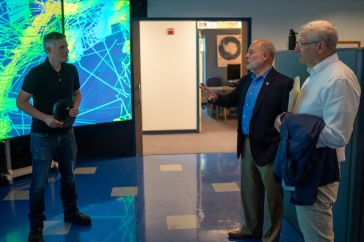
In a paper recently published in Science Advances, Earth sciences Ph.D. student Abigail D'Ambrosia linked past global warming with mammalian shrinking.

More than 50 million years ago, when the Earth experienced a series of extreme global warming events, early mammals responded by shrinking in size. While this mammalian dwarfism has previously been linked to the largest of these warming events, called hyperthermals, research led by UNH has found that this evolutionary process can happen in smaller hyperthermals, indicating an important pattern that could help shape an understanding of underlying effects of current human-caused climate change.
“We know that during the largest of these hyperthermals, known as the Paleocene-Eocene Thermal Maximum, or PETM, temperatures rose an estimated nine to 14 degrees Fahrenheit and some mammals shrank by 30 percent over time, so we wanted to see if this pattern repeated during other warming events,” says Abigail D’Ambrosia, a doctoral student at UNH and lead author of the study, published in the journal Science Advances. “The hope is that it would help us learn more about the possible effects of today’s global warming.”
For the study, researchers collected teeth and jaw fragments in the fossil-rich Bighorn Basin region of Wyoming. Their focus was on several early mammals, including Arenahippus, an early horse the size of a small dog, and Diacodexis, a rabbit-sized predecessor to hoofed mammals.
“This suggests there may be a relationship between the magnitude of a global warming event and the degree of associated mammal dwarfism.”
Using the size of the molar teeth as a proxy for body size, the researchers found a statistically significant decrease in the body size of these mammals’ during a second, smaller, hyperthermal, called the ETM2. Arenahippus decreased by about 14 percent in size, and the Diacodexis by about 15 percent.
“We found evidence of mammalian dwarfism during this second hyperthermal, however it was less extreme than during the PETM,” says D’Ambrosia. “During ETM2 temperatures only rose an estimated five degrees Fahrenheit and it was shorter, only lasting 80,000 to 100,000 years, about half as long as the larger PETM. Since the temperature change was smaller, this suggests there may be a relationship between the magnitude of a global warming event and the degree of associated mammal dwarfism.”

Researchers propose that the body change could have been an evolutionary response to create a more efficient way to reduce body heat. A smaller body size would allow the animals to cool down faster. Nutrient availability and quality in plants may have also played a role. Previous research shows that both the PETM and the ETM2 hyperthermals coincided with increased levels of carbon dioxide in the atmosphere and that could have limited nutrient quality in plants, which may have contributed to the smaller mammal body size.
Hydrological records during the PETM also suggest less precipitation and drought, which could have led to drier soils and even fire which may have affected vegetation growth and eventually possibly offspring size. After both hyperthermal events, body sizes on all mammals rebounded.
The carbon dioxide released during both hyperthermals has a similar footprint to today’s fossil fuels. Researchers hope that developing a better understanding of the relationship between the change in mammalian body size during those events and today’s greenhouse gas-induced global warming may help to better predict possible future ecological changes in response to today’s climate changes.
Co-authors include William Clyde, professor of Earth sciences at UNH; Henry C. Fricke, Colorado College; Philip D. Gingerich, University of Michigan; Hemmo A. Abels, Delft University of Technology, Netherlands. The preliminary findings were presented earlier at the Society of Vertebrate Paleontology’s 2013 annual meeting.
D’Ambrosia received funding for this project from two Geological Society of America Graduate Research Grants, a Paleontological Society Student Research Grant, and a Sigma Xi Grant-in-Aid. This project was also supported by the National Science Foundation and the Nederlandse Organisatie voor Wetenschappelijk Onderzoek. Fossils were collected under a U.S. Bureau of Land Management permit.

-
Written By:
Robbin Ray ’82 | UNH Marketing | robbin.ray@unh.edu | 603-862-4864



















































